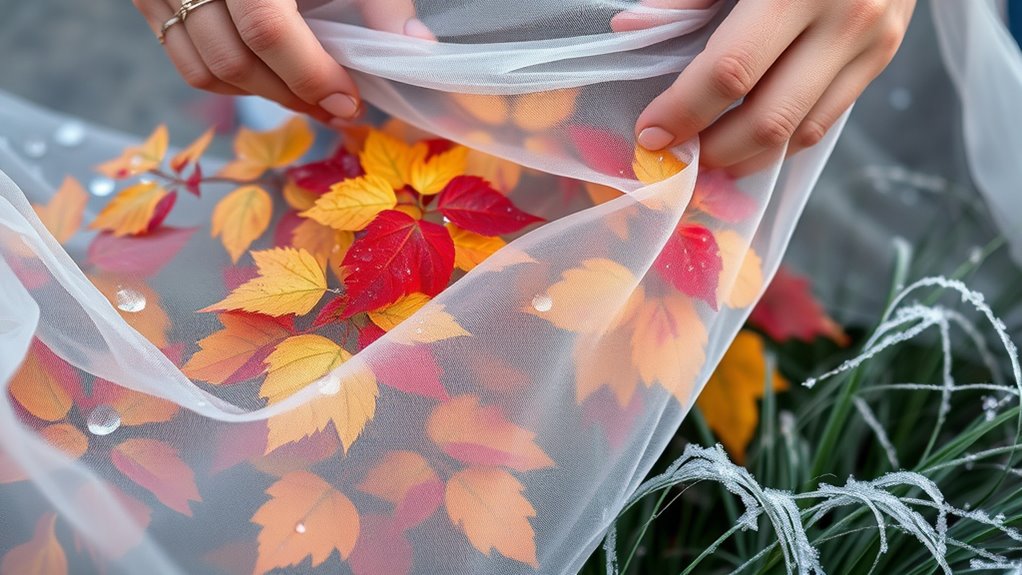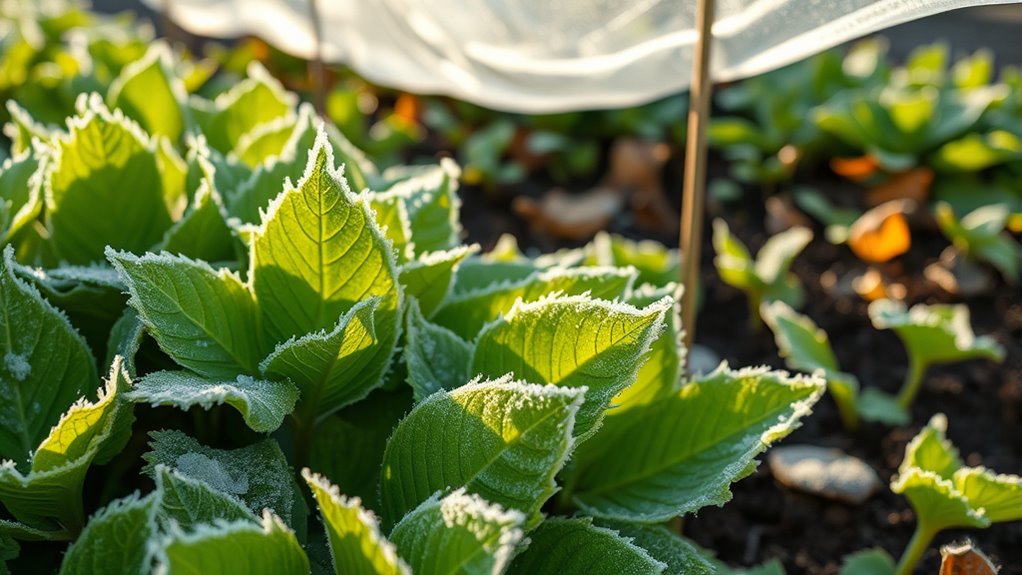To protect your plants from late fall frost, monitor weather forecasts and know your area’s first frost date. Cover vulnerable plants with breathable materials like frost cloths or blankets before temperatures drop below freezing, and secure them well around the base. Mulch plants to insulate roots or move container plants indoors or to sheltered spots. Starting early and staying attentive to cold snaps helps prevent damage, and you’ll discover more tips for keeping plants safe during chilly weather.
Key Takeaways
- Monitor local frost dates and weather forecasts to anticipate cold snaps.
- Cover vulnerable plants with breathable materials like frost cloths or blankets before temperatures drop.
- Mulch around plant bases to insulate roots and retain soil warmth during late fall freezes.
- Move container plants indoors or to sheltered areas before frost occurs.
- Proactively protect plants as the last expected frost date approaches to extend their safety.

As temperatures decline, it is vital to take steps to protect your plants from frost damage. Understanding plant hardiness is essential because it tells you which plants can withstand cooler temperatures and which ones need extra protection. Check the USDA plant hardiness zones for your area to identify which plants are most vulnerable as the weather turns colder. Knowing the typical frost dates for your region also helps you plan ahead. Frost dates indicate when the first and last frosts are likely to occur, so you can time your protective measures accordingly.
Understanding your USDA hardiness zone and frost dates helps protect plants from cold damage.
Once you know your area’s frost dates, you can start preparing your plants early. As fall progresses and temperatures drop, keep a close eye on the weather forecast. When a cold snap is forecasted, it’s time to act. Covering your plants before temperatures fall below freezing can prevent frost damage. Use materials like frost cloths, old blankets, or burlap—these allow air circulation while providing insulation. Avoid using plastic sheets directly on plants because they can trap moisture and cause more harm than good. Secure covers well around the base of plants to trap heat and prevent cold air from seeping in.
If you have tender or young plants that are particularly sensitive to cold, consider relocating them to a protected area, such as a garage or shed, during cold nights. Container plants can be moved indoors or into a sheltered spot to avoid frost altogether. For added insulation, place mulch around the base of your garden plants, which helps retain soil warmth and protect roots from freezing temperatures. Mulching is especially effective for perennials and shrubs that are borderline hardy. Additionally, understanding plant hardiness zones can guide you in selecting plants that are better suited for your climate, reducing the need for extra protections.
Timing is key. As you approach the last expected frost date, start implementing these protective measures proactively. Even if the forecast indicates a sudden cold spell, having your plants covered or moved beforehand minimizes the risk of frost damage. Remember that plant hardiness varies, so what works for some plants might not be enough for others. Regularly monitoring the weather and adjusting your strategies based on frost forecasts will ensure your plants stay healthy through late fall. By understanding your local climate’s frost dates and selecting appropriate protections, you can extend your growing season and keep your garden thriving despite the chill.
Frequently Asked Questions
When Is the First Expected Frost in My Area?
The first expected frost in your area typically occurs around late October to early November, depending on your local seasonal climate. Keep an eye on frost prediction updates from your weather service, as temperatures can fluctuate year to year. To stay prepared, monitor local forecasts regularly and consider protecting your plants once the forecast predicts a drop below freezing, ensuring they survive the early cold snap.
Which Plants Are Most Vulnerable to Late Fall Frost?
You should watch out for tender foliage and evergreen shrubs, as they’re most vulnerable to late fall frost. Tender plants like tomatoes, peppers, and delicate flowers can suffer damage if temperatures drop suddenly. Evergreen shrubs, while more hardy, can still sustain harm to their foliage or branches if frost is severe. To protect these plants, consider covering them with frost cloths or bringing potted plants indoors before the first frost hits.
How Can I Tell if My Plant Has Been Frost-Damaged?
Frost damage symptoms can look like your plant has been sprinkled with icy glitter, turning leaves brown, wilted, or black. You might notice brittle stems or mushy spots. To check, gently scrape a bit of bark—if it’s brown beneath, frost has penetrated. For plant recovery tips, prune away damaged parts, keep the soil moist, and wait patiently for new growth. Stay attentive, and your plant can bounce back.
Are There Natural Remedies to Protect Plants From Frost?
Yes, you can use natural remedies to protect your plants from frost. Try companion planting with frost-resistant herbs or flowers that act as natural antifreeze, creating a microclimate around your plants. Cover vulnerable plants with straw, mulch, or old blankets at night for extra warmth. These natural methods help insulate and shield your plants, reducing frost damage and keeping them healthy through late fall.
Can Indoor Plants Also Be Affected by Late Fall Frost?
Indoor plants can be affected by late fall frost if you don’t take proper indoor plant care. Cold drafts, unheated rooms, or windows left open expose them to frost impact, causing damage or death. To keep your indoor plants safe, move them away from cold windows, insulate pots, and maintain a consistent temperature. Being proactive helps prevent frost damage and keeps your plants healthy during late fall.
Conclusion
As you prepare your garden for the colder nights, remember that your efforts can unexpectedly save more than just plants—they can preserve memories of seasons gone by. It’s almost poetic how a simple cover or a bit of mulch can shield your garden and safeguard your cherished blooms. When frost threatens, your care becomes a silent promise that, no matter the weather, your love for your plants will always shine through.









